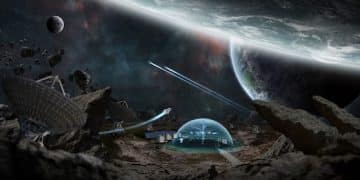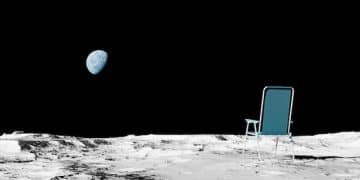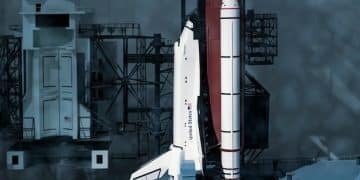Moon’s Far Side: New Ice Discovery & Future Missions Implications
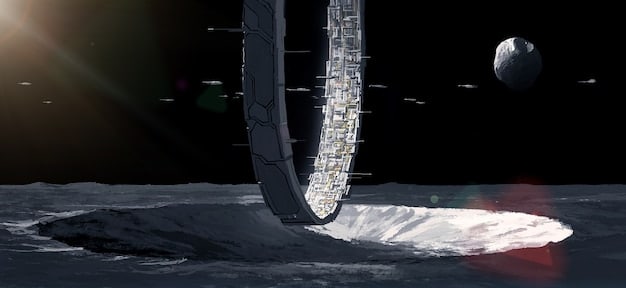
Recent findings strongly suggest the presence of significant water ice deposits on the Moon’s far side, a discovery poised to revolutionize future lunar missions by providing in-situ resource utilization opportunities and establishing long-term human presence.
The quest to understand the Moon has captivated humanity for centuries, evolving from telescopic observations to ambitious crewed and robotic missions. Now, new evidence suggests potential water ice deposits on the far side of the Moon – what does this mean for future missions? This groundbreaking development could fundamentally alter our approach to lunar exploration and colonization.
The Hidden Face: Understanding the Lunar Far Side
For millennia, the Moon’s far side remained an enigma, perpetually hidden from Earth’s gaze due to tidal locking. This distinct hemisphere, often mistakenly called the “dark side,” receives just as much sunlight as the near side, but its unique geological characteristics and environmental conditions set it apart. Recent technological advancements, particularly with advanced orbital imaging and radar systems, have begun to peel back this celestial curtain, revealing intriguing features.
Unlike the smooth, maria-dominated near side, the far side is heavily cratered. This rugged terrain is a testament to billions of years of cosmic bombardment, with many craters acting as cold traps—regions where temperatures are so low that volatile compounds, like water ice, could remain stable for eons. The absence of Earth’s radio interference also makes the far side an ideal location for radio astronomy, offering unparalleled views of the universe without terrestrial noise. These environmental specificities have historically made exploration challenging but also incredibly rewarding.
Geological Peculiarities and Cold Traps
The far side’s crust is notably thicker, and it lacks the extensive volcanic plains, or maria, that characterize the near side. This geological difference is thought to be tied to the Moon’s early formation and evolution, influencing heat distribution and volatile retention. The abundant impact craters, especially those in shadowed polar regions, are particularly significant in the context of water ice.
- Permanently Shadowed Regions (PSRs): These areas, primarily located within deep craters near the lunar poles, never receive direct sunlight. Temperatures within PSRs can plummet to below -240 degrees Fahrenheit (-150 degrees Celsius), creating ideal conditions for water ice to exist long-term.
- Volatile Preservation: When comets and asteroids impact the Moon, they deliver water and other volatiles. In sunlit areas, these compounds quickly sublime away. However, within PSRs, these volatiles can freeze and accumulate, preserving them for billions of years.
Understanding these geological nuances is crucial for identifying precise locations where water ice might be most prevalent. Early missions hinted at these possibilities, but current technology allows for much more detailed and compelling data collection, moving from theoretical possibility to near certainty.
Historical Exploration and Early Hints of Water
The first glimpse of the far side came with the Soviet Luna 3 mission in 1959. Subsequent missions, including Apollo 8, further mapped its features. While early lunar missions primarily focused on the near side for human landings, scientific interest in the far side grew steadily, especially regarding its potential as a water resource.
Initial evidence for lunar water, in trace amounts, came from spectral data collected by missions like Deep Impact and Cassini in 2009. Later, the Lunar Reconnaissance Orbiter (LRO) and Chandrayaan-1’s Moon Mineralogy Mapper (M3) provided more definitive spectroscopic evidence of water molecules and hydroxyl present across the lunar surface, although concentrated at the poles. These findings were significant, but the challenge remained in confirming substantial, accessible deposits, especially on the elusive far side.
The implications of confirming accessible water ice are enormous, essentially providing a stepping stone for sustainable lunar operations. This transforms the Moon from a mere destination into a potential staging ground for deeper space exploration. The journey from initial speculation to concrete evidence has been a long one, marked by incremental but significant discoveries.
The Latest Evidence: Unpacking the New Discoveries
The recent surge in evidence for water ice on the Moon’s far side is not based on a single, isolated finding but rather a confluence of data from multiple advanced instruments and analytical techniques. This multidisciplinary approach lends significant credence to the new conclusions, moving beyond previous estimations to solidify the hypothesis of substantial, accessible deposits. The implications of these validated discoveries are profound for future lunar endeavors.
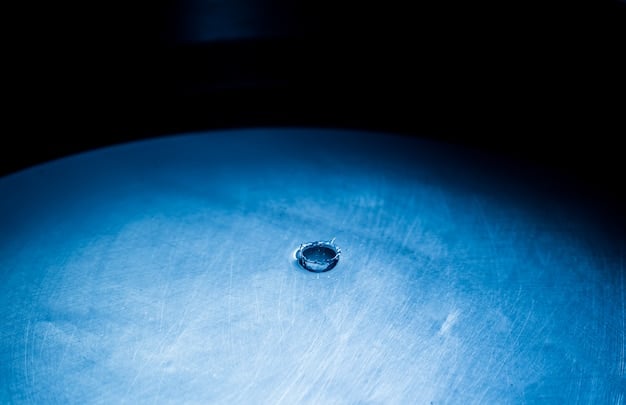
Advanced Orbital Radar and Spectroscopic Data
One of the primary drivers behind these new discoveries is the deployment of more sophisticated orbital radar systems. Traditional radar can detect variations in surface reflectivity, but advanced synthetic aperture radar (SAR) systems can penetrate deeper into the regolith, providing insights into subsurface structures and material composition. Anomalies in radar signals, particularly strong reflections from PSRs, are consistent with the presence of ice rather than dry rock.
- Ground-Penetrating Radar (GPR): Newer GPR instruments aboard orbiters are capable of mapping subsurface layers. Distinct reflections at certain depths within polar craters suggest layers of ice mixed with lunar regolith. This offers a three-dimensional perspective, going beyond surface detection.
- Improved Spectrometers: While older spectrometers could detect water molecules, the latest generation offers higher spectral resolution and signal-to-noise ratios. This allows for more precise identification of the chemical bonds characteristic of water ice, distinguishing it from hydroxyl or adsorbed water. Data from instruments like the Lunar IceCube mission and subsequent analyses of LRO data have refined these detections, confirming signatures specifically associated with solid H2O.
These technological leaps enable scientists to not only confirm the presence of water but also to begin estimating its quantity and distribution with greater accuracy. This level of detail is critical for mission planning.
Confirmation from Diverse Scientific Instruments
Beyond radar and spectroscopy, other instruments and analytical techniques contribute to the growing body of evidence. Neutron spectrometers, for instance, can detect hydrogen, a key component of water. Abnormal concentrations of hydrogen within specific far-side craters strongly imply the presence of water ice, as hydrogen is much rarer in its isolated form on the Moon.
Furthermore, theoretical modeling and simulations, informed by geological data and thermal properties, have also been refined. These models predict that given the extreme cold and perpetual shadow in certain regions, water ice would indeed be stable over geological timescales. When these refined models align with observational data from multiple, independent instruments, the confidence in the findings escalates dramatically. The convergence of these diverse lines of evidence paints an increasingly clear picture of substantial water reserves.
What makes these new findings particularly noteworthy is the strength of corroboration. It’s not just one mission or one type of sensor; it’s a mosaic of data points, each independently pointing towards the same conclusion. This comprehensive validation significantly reduces the previous uncertainties and strengthens the case for accessible water on the Moon’s far side.
Implications for Future Lunar Missions
The confirmed presence of significant water ice deposits on the Moon’s far side represents a game-changer for future space exploration. It shifts the paradigm from a purely scientific endeavor to one that also encompasses resource utilization and long-term human presence. This discovery fundamentally alters strategic planning for the next phase of lunar missions, making ambitious proposals far more feasible and sustainable.
In-Situ Resource Utilization (ISRU)
Perhaps the most immediate and profound implication of lunar water ice is its potential for In-Situ Resource Utilization (ISRU). Water can be broken down into hydrogen and oxygen—two essential components for life support and propellant. Producing these resources on the Moon dramatically reduces the mass that needs to be launched from Earth, thereby cutting costs and enhancing mission sustainability.
- Propellant Production: Liquid hydrogen and liquid oxygen are powerful rocket propellants. Establishing a facility to convert lunar water ice into rocket fuel means that future missions could refuel at a lunar depot before embarking on longer journeys to Mars or beyond. This “gas station in space” concept could unlock new dimensions of deep-space exploration.
- Life Support Systems: Water is indispensable for human survival. It can be used for drinking, hygiene, radiation shielding, and agriculture in future lunar habitats. Recycling water efficiently on the Moon would create a closed-loop life support system, minimizing reliance on costly resupply missions from Earth.
- Construction Materials: Beyond life support and propellant, water can be a component in various construction techniques. For example, some proposals involve using water to create lunar concrete or as a medium for 3D printing structures.
The ability to live off the land, even to a limited extent, is a critical step towards genuine off-world colonization. ISRU transforms the Moon from a static destination into a dynamic hub for resource generation and logistical support, reducing the economic and logistical burden of lunar and deep-space endeavors.
Establishing Long-Term Human Presence
The availability of water ice isn’t just about resource extraction; it’s about enabling sustainability for human outposts. Sustained human presence on the Moon requires more than mere survival; it demands infrastructure, resources, and a degree of self-sufficiency. Water ice facilitates this long-term vision, paving the way for research stations and even permanent settlements.
Robotic missions would likely precede human construction, mapping the precise location and accessibility of ice, and establishing initial processing capabilities. Subsequent human missions could then focus on scaling up operations, building more sophisticated habitats, and conducting extensive scientific research. A continuous human presence would transform our understanding of the Moon, its history, and its potential as an off-world home.
Furthermore, a lunar base powered by locally sourced resources could serve as an unparalleled scientific laboratory. Researchers could conduct experiments in low gravity, study the origins of the solar system through lunar geology, and establish unique observatories shielded from Earth’s interference. The far side’s radio quietness, combined with local resource availability, makes it a prime candidate for future astronomical facilities.
Technological Challenges and Solutions
While the prospect of abundant water ice on the Moon’s far side is tantalizing, its extraction and utilization are far from straightforward. The lunar environment presents unique and formidable challenges that require innovative technological solutions. Addressing these hurdles will be paramount to realizing the full potential of these newly discovered resources.
Extreme Cold and Regolith Handling
The permanently shadowed regions (PSRs) where water ice is concentrated are, by definition, extremely cold. Temperatures can drop to near absolute zero, posing severe challenges for equipment and human operations. Traditional terrestrial machinery is not designed to function reliably in such cryogenic conditions.
- Cryogenic Engineering: Future lunar mining equipment must incorporate advanced materials and lubrication systems that can operate effectively in extreme cold. Heating elements will be necessary to keep essential components from freezing, adding to power requirements.
- Regolith Management: Lunar regolith, the dusty layer covering the Moon, is abrasive and can damage machinery. Extracting ice requires excavating this regolith, which is also electrostatically charged, causing it to cling to surfaces. Specialized drills, excavators, and conveyer belts designed to handle this fine, sharp dust in sub-zero temperatures are essential.
Developing robust, cold-resilient robotics that can handle the lunar dust is a critical engineering challenge. These machines will need to be highly autonomous, given the communication delays with Earth when operating on the far side.
Powering Far Side Operations
The Moon’s far side, while receiving sunlight, does not allow a continuous view of Earth. This impacts communication and, crucially, power generation. Solar panels are a primary power source for many space missions, but their efficiency diminishes drastically in cold temperatures, and they are ineffective in the shadowed crater interiors where ice is found.
To overcome this, alternative power solutions are being explored:
- Radioisotope Thermoelectric Generators (RTGs): These devices convert heat from the decay of radioactive isotopes into electricity. RTGs offer a continuous, reliable power supply independent of sunlight, making them ideal for PSR operations. However, their use is limited by the availability of radioactive materials and safety concerns.
- Small Nuclear Fission Reactors: More ambitious plans involve deploying small modular fission reactors on the lunar surface. These can provide substantial and consistent power, capable of supporting large-scale mining and processing operations, as well as human habitats. Projects like NASA’s Kilopower are exploring this option.
The choice of power source will depend on the scale and longevity of the mission. For initial reconnaissance and smaller-scale extraction, RTGs might suffice. For sustained production and establishing a base, fission reactors become increasingly necessary, demanding significant investment and technical development.
Ultimately, a combination of these technologies, perhaps with small, highly efficient solar arrays for equipment operating outside the deepest shadows, could provide the redundancy and power necessary for successful far side operations. These are not trivial challenges, but the potential rewards of lunar water ice justify the immense technological investment.
International Collaboration and Geopolitical Considerations
The Moon, particularly its resource-rich polar regions, is increasingly becoming a focal point for international ambition. The confirmed presence of water ice on the far side amplifies this interest, raising important questions about ownership, access, and cooperation. The exploration and utilization of lunar resources will inevitably involve complex geopolitical considerations and the need for robust international frameworks.
The Artemis Accords and Space Law
As more nations and private entities set their sights on the Moon, existing space law, primarily the 1967 Outer Space Treaty, faces new challenges. While the treaty prohibits national appropriation of celestial bodies, it doesn’t explicitly address the exploitation of resources. This ambiguity has led to initiatives like the Artemis Accords, led by the United States.
- Artemis Accords: This set of non-binding principles aims to guide civil space exploration and resource utilization, promoting transparency, peaceful cooperation, and the orderly conduct of activities in space. Signatories agree to principles of responsible behavior, including the establishment of “safety zones” around operational areas to prevent harmful interference.
- Ongoing Debates: Despite the Accords, there are ongoing debates within the international community regarding the legal framework for space resource exploitation. Questions persist about whether extracted resources become the property of the extractor, how to share benefits, and how to resolve disputes.
The development of clear, universally accepted legal frameworks will be essential to prevent potential conflicts and ensure equitable access to lunar resources. The Moon’s water ice could either be a catalyst for unprecedented global cooperation or a flashpoint for competition.
Competitive vs. Collaborative Approaches
The race for lunar resources could take various forms. A purely competitive approach might see nations and corporations vying for prime resource sites, potentially leading to disputes and rapid depletion. However, a collaborative model offers significant advantages, pooling resources, sharing risks, and accelerating scientific and technological progress.
Many space agencies and private companies recognize the immense costs and technological hurdles involved in lunar exploration. Partnerships, like those being established under the Artemis program, demonstrate a shift towards a more collaborative model. Sharing data, developing common standards, and even jointly operating infrastructure could prove more efficient and sustainable in the long run.
China and Russia, for example, have their own joint lunar station plans, signaling their intent to establish a significant presence. The interaction between these separate but potentially overlapping ventures will be a key aspect of future lunar geopolitics. The Moon’s ice reserves are not infinite, and thoughtful, collaborative stewardship will be critical to their long-term benefit for humanity.
The future of lunar exploration hinges not just on technological prowess but also on diplomatic skill and the ability of nations to forge common ground in the pursuit of scientific discovery and resource utilization. The far side’s ice could serve as a powerful incentive for both cooperation and strategic positioning.
Environmental and Ethical Considerations
As humanity prepares to potentially extract and utilize resources from the Moon, it becomes imperative to consider the environmental and ethical implications of such endeavors. The Moon, while seemingly barren, is a unique celestial body with its own scientific and historical value. Ensuring responsible exploration and avoiding irreversible harm is a critical dimension of future lunar missions.
Preserving Lunar Heritage and Scientific Value
The Moon carries significant scientific and historical heritage. Landing sites from the Apollo missions, for instance, are considered archaeological sites of immense importance. Furthermore, pristine lunar environments, especially the ancient, cold-trapped regions, hold invaluable records of the early solar system. Uncontrolled excavation of ice could disturb these pristine environments and destroy unique scientific data.
- Pristine Environments: Scientists are keen to study the undisturbed lunar regolith and ice for clues about the Moon’s formation, the delivery of volatiles to the inner solar system, and the origins of life. Disrupting these environments could erase critical scientific information before it can be collected.
- Contamination Concerns: Human activities introduce contaminants, both biological and chemical, to the lunar environment. Preventing terrestrial microbes from contaminating potential lunar water sources or other scientifically sensitive areas is a significant challenge. Adhering to strict planetary protection protocols is essential to preserve the Moon’s pristine state for future scientific investigation.
Striking a balance between resource extraction and scientific preservation will require careful planning and international agreement. Designating protected zones, similar to national parks on Earth, for areas of exceptional scientific or historical value could be one approach.
Long-Term Sustainability and Lunar Impact
Any large-scale industrial activity, even in space, has environmental consequences. While the Moon lacks an atmosphere and biosphere in the terrestrial sense, large-scale mining operations could generate significant amounts of dust, alter surface reflectivity, and generate heat. These changes, though seemingly minor, could have unforeseen long-term impacts on the very environment we seek to utilize.
Key considerations for long-term sustainability include:
- Resource Depletion: While the ice deposits appear substantial, they are finite. Ensuring that extraction rates are sustainable and that alternative resource strategies are explored will be important for future generations of lunar inhabitants.
- Waste Management: Lunar mining and processing will generate waste materials. Developing efficient methods for waste disposal or recycling on the Moon itself, rather than accumulating debris, is crucial.
- Dark Sky Preservation: The far side is particularly valuable for radio astronomy due to its shielding from Earth’s radio noise. Large-scale industrial operations could generate their own electromagnetic interference, compromising this unique scientific asset.
Ethical considerations extend to the very idea of altering another celestial body for human benefit. Are we merely extending our dominion, or are we striving for harmonious coexistence with the cosmos? These questions underscore the need for a thoughtful, deliberate approach to lunar colonization, guided by principles of stewardship and foresight.
Ultimately, the discovery of water ice marks an unprecedented opportunity, but also demands unprecedented responsibility. Humanity’s presence on the Moon should be characterized by careful planning, respect for the lunar environment, and a commitment to long-term sustainability, ensuring that the benefits of space exploration are realized without compromising its inherent scientific and ethical values.
The Next Steps: Missions and Roadmaps
The confirmed presence of water ice on the Moon’s far side is not merely a scientific curiosity; it’s a call to action. Space agencies and commercial entities are now actively developing ambitious plans to investigate, access, and ultimately utilize these resources. The next decade promises to be a period of intense lunar activity, transitioning from initial reconnaissance to the establishment of the groundwork for sustained lunar operations.
Planned Missions and Lunar Lander Initiatives
Several missions are already in various stages of planning and development, specifically targeting lunar polar regions and, increasingly, the far side. These missions aim to refine our understanding of ice distribution, assess its accessibility, and test extraction technologies.
- NASA’s Artemis Program: Central to NASA’s strategy, Artemis aims to return humans to the Moon, focusing on the lunar south pole due to its PSRs and potential water ice. While initial human landings are likely on the near side of the south pole, subsequent missions would undoubtedly venture into far-side ice-rich regions. Robotic precursors, such as the Volatiles Investigating Polar Exploration Rover (VIPER), are designed to map and characterize ice deposits in detail.
- Commercial Lunar Payload Services (CLPS): NASA is leveraging commercial partners through the CLPS initiative to deliver scientific instruments and technology demonstrations to the lunar surface. Many CLPS missions are targeting polar regions to investigate water ice, laying the groundwork for more complex operations.
- International Collaboration and Independent Missions: Beyond U.S. efforts, others are forging ahead. China’s Chang’e program has already landed on the far side (Chang’e 4) and retrieved lunar samples (Chang’e 5 from the near side). Future Chang’e missions are expected to target the lunar south pole for ice retrieval. JAXA (Japan), ESA (Europe), and ISRO (India) also have advanced lunar exploration plans, often involving partnerships to leverage combined expertise and resources.
These missions represent a diverse portfolio of approaches, ranging from small, agile commercial landers to the complex, human-crewed Artemis program. Their cumulative data will provide an unprecedented level of detail about lunar water resources.
Developing Extraction and Processing Technologies
Even with confirmed ice, the challenge remains: how to efficiently extract it and process it into usable resources. Extensive research and development are underway to create the necessary robotic and processing infrastructure.
Key technologies being developed include:
- Excavation Tools: Specialized drills, shovels, and robotic arms capable of operating in cryogenic temperatures and handling abrasive regolith are essential. Prototypes are being tested in Earth-based lunar simulants.
- Ice Melting and Vaporization Systems: Methods for extracting water from ice-rich regolith include heating it to sublimate the ice into vapor, which can then be collected and purified. Techniques like microwave heating or solar concentrators are being explored.
- Water Purification and Electrolysis: Once collected, raw lunar water must be purified. Electrolysis units will then break down the water into hydrogen and oxygen. These systems need to be compact, energy-efficient, and capable of long-term operation in a space environment.
The roadmap for lunar water utilization involves a phased approach: initial robotic scouting, followed by small-scale demonstration missions, escalating to larger-scale pilot plants, and eventually full-blown operational facilities. Each step builds upon the successes and lessons learned from the previous, steadily advancing humanity’s capability to live and thrive beyond Earth.
The discovery of water ice on the Moon’s far side is not the end of a quest, but the beginning of a new chapter in lunar exploration—a chapter where challenges transform into opportunities, and dreams of off-world living move closer to reality.
| Key Finding | Implication for Future Missions |
|---|---|
| 🧊 Confirmed Water Ice Deposits | Paves the way for In-Situ Resource Utilization (ISRU) for propellant and life support. |
| 🌑 Far Side Location | Requires advanced robotics and power solutions due to extreme cold and communication challenges. |
| 🚀 Reduced Mission Costs | Local resource production drastically cuts down mass requirements from Earth, making deep space more accessible. |
| 🤝 Geopolitical Landscape | Demands international cooperation and clear legal frameworks for resource exploitation. |
Frequently Asked Questions
Water ice is a fundamental resource for space exploration. Its presence on the Moon means it can potentially be converted into essential consumables like drinking water, oxygen for breathing, and hydrogen/oxygen propellants for rockets. This significantly reduces the need to launch these heavy resources from Earth, making future lunar and deep-space missions more sustainable and cost-effective.
The latest evidence stems from advanced orbital radar systems, improved spectrometers, and neutron spectrometers. These instruments can penetrate the lunar regolith and specifically detect signatures consistent with solid water ice within permanently shadowed regions (PSRs) of craters, especially near the lunar poles, including those on the far side. The convergence of data from multiple independent instruments strengthens these findings.
Key challenges include the extreme cold temperatures within permanently shadowed regions (down to -240°C), the abrasive nature of lunar regolith, and the difficulty of providing continuous power in shadowed areas. Developing robotic equipment that can withstand these conditions, alongside robust power solutions like radioisotope thermoelectric generators or small nuclear fission reactors, is crucial for successful extraction.
The discovery of water ice significantly enhances the feasibility of establishing long-term human presence. With accessible water, future lunar habitats can access resources for life support, hygiene, and even agriculture. This local resource generation allows missions to be less reliant on Earth resupply, facilitating more sustainable and ambitious lunar outposts and potentially serving as a stepping stone for further deep-space exploration.
The potential for resource exploitation on the Moon raises complex questions regarding ownership, access, and international law. Agreements like the Artemis Accords aim to establish principles for responsible space resource utilization. The discovery underscores the need for clear legal frameworks and promotes both competitive initiatives among nations and increasing international collaboration to ensure peaceful and equitable access to lunar resources for the benefit of all humanity.
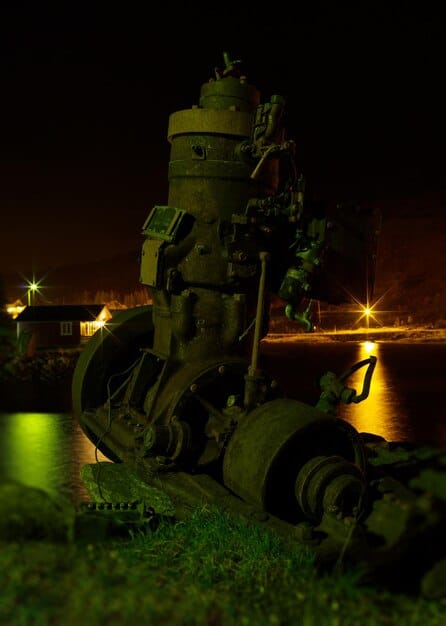
Conclusion
The definitive evidence of significant water ice deposits on the Moon’s far side marks a pivotal moment in space exploration. This discovery transcends mere scientific curiosity, fundamentally reshaping the strategic landscape for future lunar missions. From enabling In-Situ Resource Utilization—crucial for manufacturing rocket fuel and sustaining life support—to paving the way for long-term human outposts, the implications are profound. While technological hurdles related to extreme cold and powering far-side operations remain, ongoing research and international collaborations are actively developing innovative solutions. This celestial treasure transforms the Moon from a distant destination into a viable stepping stone, promising a more sustainable, affordable, and ambitious future for humanity’s journey among the stars. The far side, once hidden, now beckons as a beacon for our cosmic ambitions.
